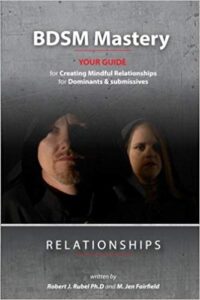
This is the second book in the BDSM Mastery series. While the first book oriented readers to play, parties, and scene protocols, this book addresses Dominant/submissive relationships.What, you might ask, are “BDSM Relationships?”These are “adventuresome” relationships. Relationships that are not exactly like vanilla relationships. BDSM relationships differ in two specific ways from your typical vanilla relationship: first, they usually involve a power-imbalanced structure (one person is clearly in charge and the other person is clearly following); second, the kind of sex that adventuresome folks practice is, well, not vanilla.I wrote this book to help you better to understand the power dynamics that get involved with what are called power-imbalanced relationships (usually referred to as Dominant/submissive or D/s relationships).
Review
I have wanted to read something by Dr. Robert Rubel for some time now. I have heard from various sources around the internet, especially after hearing his interview on Dan and dawn’s Erotic Awakening podcast and then reading lunaKM’s book review of BDSM Mastery-Your Guide to Play, Parties, and Scene Protocols. So, I picked up a copy of BDSM Mastery-A Guide for Creating Mindful Relationships for Dominants and Submissives. This is the second book in Rubel’s and Fairfield’s BDSM Mastery series. Like the first book in this series, this book is for those individuals who are beginning in the lifestyle. While this book is geared towards those who are new, anyone who is involved in the lifestyle can take something away from this book.
The authors cover a lot of really great and useful information in this book. While the main focus of the book is about relationships, in the first chapter, the authors talk about topics such as protecting your reputation, open-mindedness, how to explore the world of D/s safely, and most importantly, explaining that what one may see going on at a play party or much isn’t always going to be what you may think you’re seeing.
In the following chapters, this is when the topic of relationships begin. There are a lot of lists throughout the rest of the book, but they are some really awesome lists that cover vetting a future partner, thinking about what you’re looking for in a partner, the type of relationship you’re looking for, what a good partner looks like, red flag behaviors, and one of my personal favorites, a list for self-examination.
The authors also talk about new relationship energy and the importance of taking things slow in the beginning, roles within the relationship, specific characteristics that are in a D/s and M/s based relationships, sadist and masochist relationships, as well as a little bit about polyamorous relationships.
In the last two chapters of the books, he speaks about negotiations, contracts, and collars-all very important things that take place in a BDSM relationship as well as expanding on some key concepts that has been mentioned in previous chapters. At the end of the book, there are some fantastic resources that I highly suggest every reader checks out. Also through the book you will find quotes from well-respected educators and authors from within the BDSM community and these do add so much to the book.
While I was reading, I found myself highlighting and making notes from so many of the passages. There is so much pertinent information in this book that I highly suggest not skipping over any of the chapters. If you skip a chapter, there’s a lot you will be missing. After reading this book, I am really looking forward to reading more of Rubel’s work in the future.


